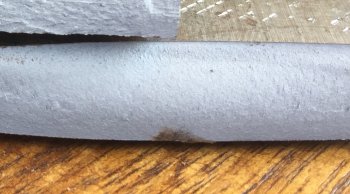Tim Lemke
Member
I'm reading up on this in bladesforum.com but figured I'd ask for some further data.
A steel comp site said to forge between 2200 and 2100???? That is really hot and narrow! I'm not sure that's applicable to knife making with forge anvil and hammer, rather than hot-roll ideal temp. This has me biting my fingernails figuratively, surely it ain't that dodgy.... Anyone got a minimum steel working temp you'd suggest? You can speak in terms of color too, that's what I'm most familiar with anyways, but a degree at which to cook would be highly appreciated. Can it be smoothed of hammer marks at red heats safely at least?
I'm seeing that it takes a usual vermiculite anneal good enough, and I'm glad of it. All my stock is hammer blanks from bonfire annealed forklift tine, truck coil spring, and annealed as needed leafspring, all hard working parts, so I would think I'd like to normalize before and after forging to make sure I do not pound in extra fatigue. Anyone have cautions towards this approach? I'd like to know.
Dooooooon't think I want to touch the triple quench some folks have touted with pretty much any chromium steel. Sounds ridiculous, and turns two HT heats into five! I don't want decarb! Says mid speed oil so gonna go for canola oil as parks 50 may be too fast if it says preheat the canola.
The steel comp site said 800°F temper???? I don't have that capacity in my oven! That's temper as for use as spring, right? *frets*
A steel comp site said to forge between 2200 and 2100???? That is really hot and narrow! I'm not sure that's applicable to knife making with forge anvil and hammer, rather than hot-roll ideal temp. This has me biting my fingernails figuratively, surely it ain't that dodgy.... Anyone got a minimum steel working temp you'd suggest? You can speak in terms of color too, that's what I'm most familiar with anyways, but a degree at which to cook would be highly appreciated. Can it be smoothed of hammer marks at red heats safely at least?
I'm seeing that it takes a usual vermiculite anneal good enough, and I'm glad of it. All my stock is hammer blanks from bonfire annealed forklift tine, truck coil spring, and annealed as needed leafspring, all hard working parts, so I would think I'd like to normalize before and after forging to make sure I do not pound in extra fatigue. Anyone have cautions towards this approach? I'd like to know.
Dooooooon't think I want to touch the triple quench some folks have touted with pretty much any chromium steel. Sounds ridiculous, and turns two HT heats into five! I don't want decarb! Says mid speed oil so gonna go for canola oil as parks 50 may be too fast if it says preheat the canola.
The steel comp site said 800°F temper???? I don't have that capacity in my oven! That's temper as for use as spring, right? *frets*

